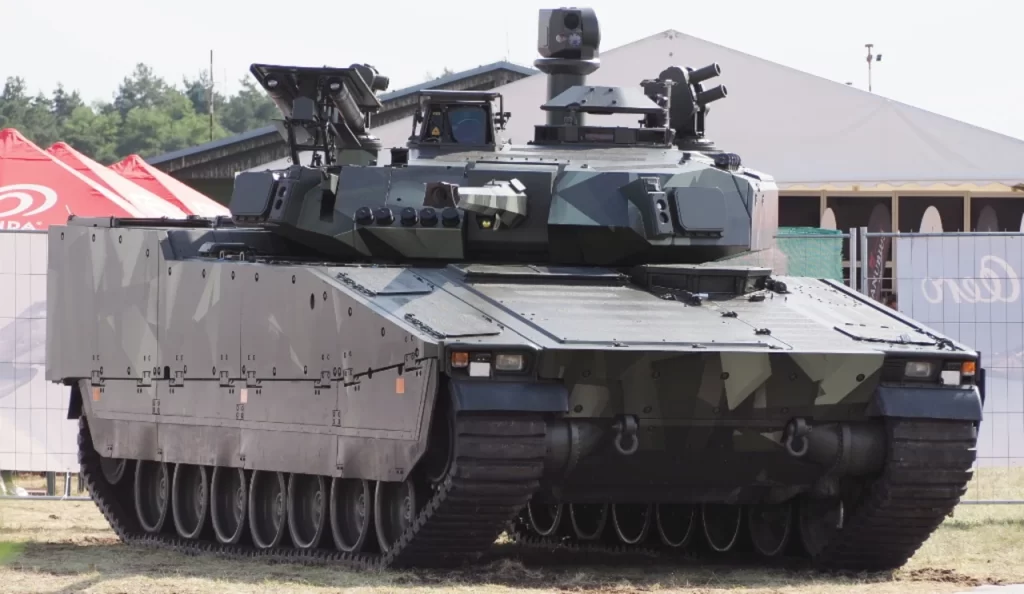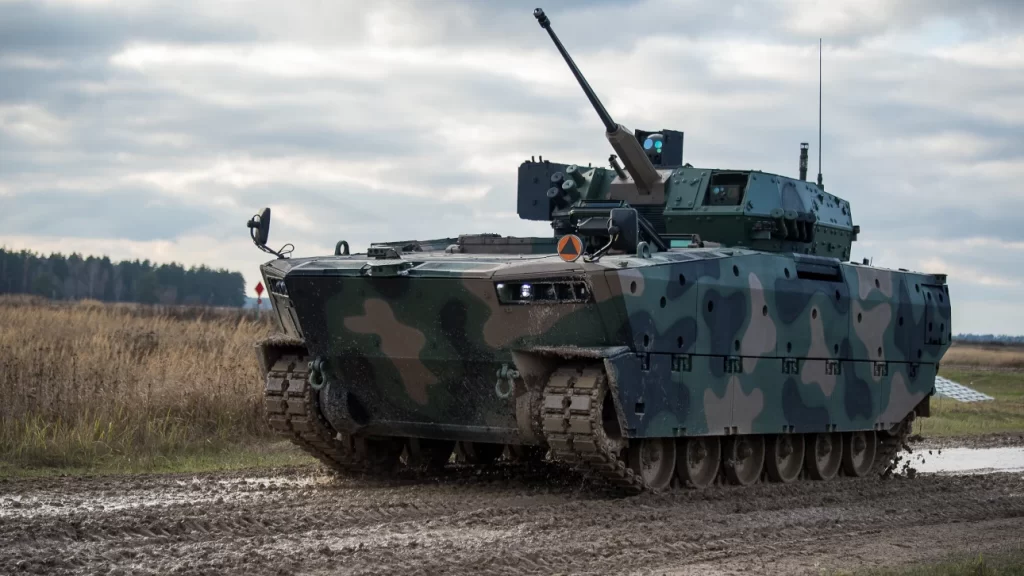As warfare becomes increasingly complex and multifaceted, the design of combat vehicles must evolve to meet both conventional and unconventional threats. Today’s battlefields demand powerful, heavily armored cars that are technologically advanced, versatile, and safe for the crew in extreme conditions. A future-ready combat vehicle incorporates cutting-edge technologies like artificial intelligence, quantum computing, and Internet of Things (IoT) capabilities, enhancing firepower, mobility, and situational awareness. In addition, it needs to protect against a wide range of new threats, such as nuclear, biological, and chemical (NBC) hazards, and include special weapons like depleted uranium (DU) armor-piercing rounds to ensure victory over enemy defenses.
Key Attributes of a Future-Ready Combat Vehicle
Protection
The primary function of a combat vehicle is to protect its crew. This involves robust armor to shield against bullets, shrapnel, and explosives. Modern armor must defend against top attacks from missiles and bottom attacks from mines or improvised explosive devices (IEDs), as well as provide secure ammunition storage in protected bustles to prevent catastrophic explosions from harming the crew.
Firepower
Precision and power are essential in combat. Precision-guided munitions (PGM) should equip future vehicles for effective long-range engagement, even beyond direct sight. The gun’s elevation and depression angles should allow for targeting in challenging terrains, such as mountains or urban settings.
Mobility and Agility
Combat vehicles must be highly mobile across various terrains, requiring advanced suspension systems for smooth travel over rough landscapes. Amphibious capabilities allow vehicles to cross rivers and other bodies of water, adding versatility. Cross-country mobility ensures the car can operate effectively in challenging environments.
Connectivity
Secure and resilient communication systems are critical. Encrypted voice and data connections enable safe, uninterrupted communication with command centers and allied forces, ensuring the crew can coordinate and respond effectively without enemy interception.
Situational Awareness
High-tech cameras and head-up displays (HUD) provide day-and-night visibility, which is essential for making quick, informed decisions. Sensors detect hidden threats and offer a comprehensive view of the surroundings, enhancing the crew’s awareness and safety.
Artificial Intelligence (AI) and Machine Learning (ML)
AI and ML are essential force multipliers on the modern battlefield, significantly enhancing a vehicle’s decision-making capabilities. By leveraging AI, the car can predict maintenance requirements, reducing unexpected downtimes and keeping the vehicle operational longer. AI also supports real-time analysis of complex battlefield data, helping to quickly prioritize targets based on threat levels, distance, and other critical factors. This means that AI and ML take over routine monitoring and data processing tasks, reducing the cognitive load on the crew, who can then focus more intently on mission-critical decisions. As a result, AI and ML make the vehicle more responsive, adaptive, and resilient in fast-paced tactical environments.
Internet of Things (IoT)
IoT connectivity transforms the combat vehicle into a node within a “smart” battlefield network, connecting it seamlessly to other cars, drones, command centers, and additional assets. This integration ensures that each vehicle has real-time updates on enemy movements, mission status, and tactical changes, enabling all connected units to respond swiftly and cohesively. The IoT’s real-time data-sharing capabilities create a more adaptive and synchronized battlefield where each vehicle benefits from shared intelligence. In a tactical battlespace, IoT-enhanced connectivity ensures that cars can dynamically adjust to changing conditions, giving forces a significant operational advantage.
Quantum Computing
Quantum computing provides a leap forward in data processing power, supporting advanced encryption and rapid, complex analysis in real time. With the high volume and sensitivity of data flowing through a modern battlefield, quantum computing enables the vehicle to perform secure, encrypted communications and efficiently analyze vast datasets for operational insights. For example, quantum computing can run complex simulations, supporting critical tactical decisions by quickly processing “what-if” scenarios. This computational power is invaluable for adaptive planning in rapidly changing threat environments, making quantum computing a core component of a modern combat vehicle’s effectiveness.

Why These Technologies Are Essential on the Modern Battlefield?
Incorporating AI, ML, IoT, and quantum computing makes a combat vehicle a powerful force multiplier in the modern tactical battlefield area (TBA). These technologies enhance situational awareness, support rapid and informed decision-making, and enable dynamic communication across the battlefield. Together, they allow the vehicle to act as both an independent and interconnected unit, enhancing the overall effectiveness of ground forces. By integrating these advanced capabilities, modern combat vehicles are better prepared to tackle complex threats, maintain operational readiness, and achieve strategic superiority in high-stakes engagements.
Active Protection Systems (APS)
Before they can strike, APS detects and neutralizes incoming threats like missiles and drones. This last line of defense provides essential protection against high-tech weaponry.
Turret Traverse Speed
Fast turret movement enables the crew to respond quickly to threats from all directions, which is essential for environments where reaction time is critical, such as urban or close-quarters combat.
Smart Drones
Deployable drones offer a valuable aerial perspective of the battlefield, enabling the vehicle to identify threats, gather intelligence, and scout ahead—all without putting the crew in harm’s way. These drones serve as additional “eyes,” significantly extending the crew’s visibility and situational awareness beyond the vehicle’s immediate vicinity. In addition to surveillance, the platform should have the capability to launch kamikaze drones, aimed at specific targets for precise attacks. This capability adds a potent offensive option that complements the vehicle’s primary and secondary armaments, effectively neutralizing distant threats while minimizing direct exposure to enemy fire. Integrating smart drones, including kamikaze variants, makes the vehicle more versatile and autonomous, enhancing its defensive and offensive capabilities in complex operational environments.
Climate Control
Reliable climate control systems maintain a comfortable and safe interior temperature, ensuring optimal crew performance across extreme climates.
Weight Optimization
Vehicles must balance armor protection with agility. Weight optimization enhances maneuverability without sacrificing durability, which is crucial for rapid response and deployment.
Modular Design
The combat vehicle’s modular design approach makes it easy to upgrade, replace, or reconfigure each system and subsystem. By designing all automotive components—such as the engine, transmission, suspension, running gear, and integrated fire control systems—to be modular, the vehicle gains significant adaptability for diverse mission requirements. This design flexibility allows for rapid upgrades and modernizations as new technologies emerge, extending the vehicle’s operational lifespan. Additionally, modular systems allow crews to make quick and efficient field repairs, minimizing downtime and maintaining combat readiness even under challenging battlefield conditions. This real-time capability to swap and repair components gives the vehicle a tactical advantage by reducing logistical dependency on maintenance support and keeping it mission-capable for longer durations.
Self-Repair Capabilities
Automated diagnostics and limited self-repair capabilities allow vehicles to handle minor repairs independently, reducing downtime and supporting prolonged missions.
Enhanced Cybersecurity
With increased digital reliance, strong cybersecurity is essential. Robust defenses protect against hacking and electronic warfare, ensuring the vehicle’s systems and communications remain secure.
Advanced Navigation Systems
GPS-independent systems like inertial navigation provide reliable positioning in GPS-denied environments, allowing the vehicle to maintain accurate navigation even under electronic jamming.
Stealth Technology and Adaptive Camouflage
Reduced radar and heat signatures make it harder for enemies to detect the vehicle. Adaptive camouflage changes to match the surroundings, providing additional concealment on the battlefield.
Extended Battery Life/Hybrid Power
Hybrid or advanced battery-powered systems extend operational range, allowing for silent movement in stealth missions and reducing dependency on fuel supply lines.
Silent Running Mode
A low-noise mode aids in the vehicle’s creep and is beneficial for missions that require stealth or a surprise approach, particularly in urban or jungle environments.
Biometric Access Control
Biometric controls, such as fingerprint or iris scanners, ensure that only authorized personnel can operate the vehicle, reducing the risk of unauthorized use or capture.
Water Purification and Storage
A water purification system allows the crew to generate clean drinking water, supporting long-duration missions and reducing reliance on external resupply.
Exoskeleton Interface
For dismounted operations, an exoskeleton interface enables the vehicle to charge and support soldiers’ exoskeleton suits, enhancing mobility and load-carrying capacity.
Crew Ergonomics and Safety
Shock-absorbing seats and ergonomic interior design reduce fatigue and enhance safety for the crew, especially during prolonged operations.
Emergency Escape Mechanisms
In an emergency, quick and secure escape options ensure crew survival by offering a safe exit if the vehicle sustains significant damage.
Bio-Monitoring Systems
Real-time health monitoring systems track the crew’s physical status, allowing for proactive care during long, intense missions.
Nuclear, Biological, and Chemical (NBC) Protection and Decontamination Kits
NBC protection systems create a sealed environment that shields the crew from hazardous materials, including radiation, toxic gases, and chemical agents. In addition, decontamination kits allow the crew to clean equipment and surfaces exposed to contaminants, ensuring continued safety and operational capability in areas affected by NBC threats.
Depleted Uranium (DU) Armor-Piercing Fin-Stabilized Discarding Sabot (APFSDS) Ammunition
APFSDS rounds use depleted uranium (DU) to penetrate heavily armored targets, often 1,000 mm thick or more. Its high density and self-sharpening characteristics make DU rounds exceptionally effective against modern armor. However, due to their radioactive properties, DU rounds pose potential health risks. Upon impact, DU can generate dust, posing long-term health hazards to crew members from prolonged exposure and environmental contamination. While DU ammunition provides superior armor-penetrating abilities, its use requires careful consideration due to its associated safety and environmental risks.

Conclusion
Designed to provide protection, adaptability, and tactical superiority on the modern battlefield, the combat vehicle of the future is a sophisticated, technologically advanced platform. Equipped with advanced features like NBC protection, DU ammunition, and intelligent systems, these vehicles prioritize crew safety and operational effectiveness. While DU rounds offer unrivaled penetration power, their health and environmental risks highlight the importance of careful ammunition selection. Future-ready combat vehicles balance traditional military strength and next-generation technology to dominate diverse and dynamic battlefields, equipping armed forces with the precision, resilience, and adaptability essential for mission success.
